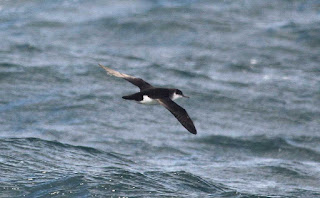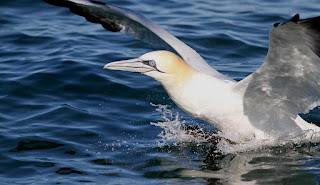Trip list of Target Species for Saturday February 16, 2013
Manx Shearwater 2
Red Phalarope 141
Razorbill 989 (mostly flying, but plenty of good looks)
Dovekie 2
Atlantic Puffin 1
We also saw Common and Red-throated Loons, Double-crested Cormorants, Brown Pelicans, many Northern Gannets at point blank range, and Bonaparte's, Herring, Lesser Black-backed, and Great Black-backed Gulls. The birds were hungry and quite responsive to our chumming all day long.
Bottlenose Dolphins, which are often very abundant on our winter trips, were present near shore in smaller than usual numbers. We also saw a Humpback Whale, which surfaced very close to the boat, and a couple of Loggerhead Turtles were seen farther offshore.
Strong winds and rough seas kept us ashore on Sunday, so we ran the second trip on Monday. It was still a bit windy when we headed out Monday morning, but we found plenty of birds close to shore in the lee of the Cape. Thirty-some hours of strong northwesterly wind had changed the water up, and we found a nice color change with 48 degree water on one side just south of Diamond Shoals. This condition was populated by many Bonaparte's Gulls and quite a few Razorbills. It was a great opportunity to photograph Razorbills, and they did not seem quite as skittish as they often are. At the same time we were watching auk after auk, the gulls were going bananas, landing on the back of the boat and eating chum right out of the scoop! I followed this color change for several miles and in doing so ended up about 14 miles southeast of Hatteras Inlet, which is not somewhere I expect to be on a winter trip. Most times we are east or even east-northeast of the inlet by late morning. I hoped we would see a puffin or a Dovekie on the color change inshore, but it did not happen. We had seen a Dovekie just east of the inlet early on, so I had high hopes. We did see some Manx Shearwaters along it though. It seemed like our best bet to find some more life and different birds would probably be a blue water change offshore, so we jogged out to the shelf break to check it out. We found a nice rip in about 100 fathoms and instantly added Red Phalarope to the day's list. There were many Bonaparte's Gulls there too. After a few minutes, we found a puffin and after several minutes of it playing hide and seek, everyone had seen it well. There were not many Razorbills on that change, but we did find a few more puffins. There was an adult Little Gull among the Boney's, but it soon disappeared, as the birds were moving quickly to the east. A Manx Shearwater gave good looks, resting on the water close to the boat before moving on. Heading back in, we had a nice ride on smoother seas and we saw a number of Razorbills, mostly within a few miles of shore. It would have been nice to see a skua, but we have missed them before, and likewise fulmars and kittiwakes. It's not everyday that we see puffins on the Hatteras trips, and the Razorbill show was the best ever, so it was definitely a trip to remember.
Trip List of Target Species for Monday February 18, 2013
Manx Shearwater 4
Red Phalarope 85
Razorbill "only" 377, but mostly on the water today, few flying
Dovekie 1
Atlantic Puffin 5
Little Gull 1
We also saw the usual loons, cormorants, scoters, pelicans, gulls, and gannets. One young Brown Pelican followed us offshore for many miles. There was a flock of six Forster's Terns on the water 17 miles out in the afternoon. We saw both inshore and offshore Bottlenose Dolphins and five Loggerhead Turtles. Gulls landed on one of the turtles, which had many barnacles on its' shell. We had a quick look at an Ocean Sunfish while underway.
I would like to thank everyone who came along. Kate Sutherland and Bob Fogg led both trips and Jeff Pippen helped on Saturday. I ran the boat and spotted a few birds too, but got to stay warmer than most.
Captain Brian Patteson
The feeding frenzy shot taken through a scupper! (Brian Patteson)
Manx Shearwater (Bob Fogg)
A very cooperative Manx Shearwater! (Bob Fogg)
Northern Gannet - at times they outnumbered the gulls around the boat! (Bob Fogg)
Northern Gannet (Bob Fogg)
Red Phalaropes (Bob Fogg)
Bonaparte's Gull and Razorbill on the water (Brian Patteson)
Second cycle Lesser Black-backed Gull (sorry for original misid!) feeding on Loggerhead Turtle's barnacles (Brian Patteson)
Breakfast at the Offshore Cafe...(Brian Patteson)
Lesser Black-backed Gull - at times they outnumbered the Great Black-backed Gulls! (Bob Fogg)
Razorbills with the beach in the background (Bob Fogg)
Razorbill (Bob Fogg)
Razorbill (Brian Patteson)
Incredible shot of Razorbills in flight! (Bob Fogg)
Razorbill (Bob Fogg)
Razorbill (Bob Fogg)
Razorbill (Brian Patteson)
The flyby Atlantic Puffin from Saturday, it was fast! (Bob Fogg)


















No comments:
Post a Comment